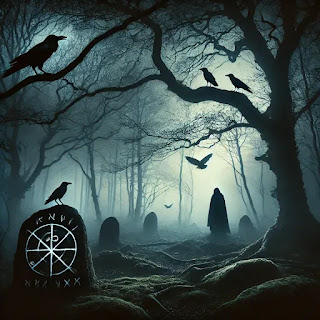Darkness is misunderstood. We’ve been taught to fear it, to push it away, to flood it with light. But in doing so, we forget that darkness is not the enemy. It is a mirror. A space where we confront the parts of ourselves we’d rather ignore. The secrets we bury, the questions we’re afraid to ask, the truths that refuse to be silenced.
This week, I’ve been thinking about why we’re drawn to dark stories. Why do we seek out tales of haunted houses, cursed woods, and forbidden knowledge? Why do we linger in the shadows when it would be easier to turn away? The answer, I think, is that darkness gives us something light cannot: perspective.
What We Find in the Shadows
Dark stories aren’t about scaring us for the sake of it. They’re about confronting the unknown, testing our courage, and finding strength in vulnerability. They give us a safe place to explore danger, heartbreak, and loss without risking anything real—except perhaps a piece of our own understanding.
This week, I revisited one of my favorite myths: the Morrigan, the Celtic goddess of war and fate. She’s a figure of power and fear, a shapeshifter who appears as a crow, a maiden, or a hag, depending on her purpose. The Morrigan doesn’t offer comfort or safety. She forces those who encounter her to face their destiny, whether they’re ready or not.
It’s no coincidence that her stories resonate with me. The Morrigan reminds us that darkness isn’t just about endings—it’s about transformation. She challenges us to let go of what no longer serves and step into what we’re meant to become, no matter how terrifying it might be.
Embracing the Shadows
In writing, darkness isn’t just a tool—it’s a necessity. It allows us to create tension, depth, and truth. Without it, our stories would feel flat, as though they were missing the texture of real life. After all, how can we appreciate the light if we’ve never known the dark?
Here’s how I bring that balance into my work:
- Conflict as Catalyst: Every character must face their own darkness—whether it’s fear, guilt, or regret. It’s not about making them suffer; it’s about showing how they grow.
- Atmosphere Matters: Shadows, whispers, and silence can say more than dialogue ever could. I try to let the setting do some of the storytelling.
- Truth in the Pain: Darkness isn’t just about horror—it’s about honesty. Sometimes, the scariest thing we can do is tell the truth, both to our characters and to ourselves.
What Darkness Speaks to You?
Think about the stories that have stayed with you long after you’ve closed the book or walked out of the theater. Were they filled with light, or were they shaped by shadow? What truths did they show you?
The darkness we crave isn’t about destruction—it’s about discovery. It’s where we go to find what’s hidden, what’s real, and what’s worth fighting for.
So let the shadows linger. They have so much to teach us.




,%20and%20a%20mischievou.webp)

No comments:
Post a Comment